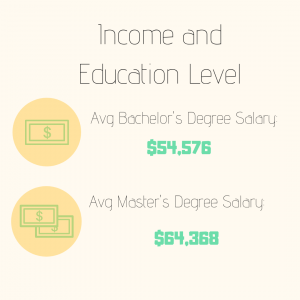College on the Company Dime
This is a guest post written by Melody from Her Designed Life. Check her out for all kinds of resources related to personal finance!
What do backpacks, pencils, and lunch bags all have in common? Their location in school!
For many people going back to school can be costly. In the United States, the national college debt is over 1.5 trillion according to Forbes magazine. After I graduated with my crushing college debt of $65k with a degree equivalent to basket weaving, I decided that I needed to cut costs, live frugal, and pay off my student loans. You can check out how I paid off my debt here.
Why I’m Going to Graduate School
As a young professional I often get asked why I have decided to go to graduate school.
Many of my friends ask why I want to add extra homework onto my day after a hard day at the office. To be honest, I don’t like extra work, but I do like extra pay.
Let’s take a look at the figures.
According to the US Bureau of Labor and Statistics, the cost of weekly pay increases with each level of educational degree you complete.
For example, the median weekly earnings for those with a bachelor’s degree estimate at $1,137.
Let’s say that of the 52 weeks there are in a year. Hypothetically, let’s say that a worker works 48 weeks due to vacations, holidays, sick days, or personal reasons.
The annual average amount that a person could potentially bring in pre-tax without any other deductions would be $54,576. Obviously, this is just an estimate of median salary and deductions and cost of living are the real determiners of your pay.
Now, let’s compare that to the average median earnings someone might receive with a Master’s degree. The median weekly earnings for those with a Master’s degree are $1,341.
Multiply this number by 48 weeks, this equates to about $64,368.
That’s about a 10,000 difference in pay for only one year!
Is Graduate School Right for Me
Before you even begin applying to graduate school, you must count the cost.
Calculate the cost of your expected income based off of a future degree or certification on one of the following websites: for general salary and experience estimates visit payscale.com and for graduate studies use this calculator. If you see that the end result of your projected income is small or only slightly more than what you currently make, re-assess the financial and career benefits of receiving your additional education.
Check out if the industry is growing fast or has high median income on the US Occupation Outlook Handbook. Most likely, if your position seems to have a high percentage of growth or an increasing median income, the investment in your education may be worth the amount of time and money spent on your program throughout your career.
Compare the tuition fees with the projected income increase. If you find that the median salary for those with your graduate level degree have a high unemployment rate or very little in income increases compared to your tuition fees, you may need to re-evaluate the type of education or professional field you are working towards.
You can create a simple formula like this to help you determine graduate level coursework.
Your current salary
– Total Cost of the program (Total cost – scholarships, grants, and tuition reimbursement)
+ Expected Annual Income Raise ( Expected Salary – Current Salary )
= Total Estimated Annual Salary post graduate or certification
Example:
$50,000
- ($15,000 – $10,500) = $5,500
- ($85,000 – $50,000) = $35,000
= $79,500 ( Total Estimated Annual Salary post graduate or certification )
* based on pre-tax and deductions
How to Qualify for Company Paid Education
Not all employers are equal, especially when it comes to paying for your graduate studies.
Here are 3 ways to get your company to pay for your ongoing education.
- Research your company’s policy on education assistance before you apply or accept a position. This is extremely important not only for traditional education, but also for ongoing certifications, seminars, etc. A company culture that approves of paying for education shows that they value their employees and their competency.
- Communicate your intentions for returning to school with your employer. If you are just starting or have been in a position with your employer for awhile, communicate to your manager your education aspirations and career goals, if they align with your current field.
- Prove the ROI. ROI stands for return on investment. Explain in detail to your manager or decision maker in your company the return on investment that paying for your education would have on the company. Perhaps there is a very large project that you could apply the theories, templates, or guides from your experience to an upcoming or long-term project.
Now that you’ve proved the ROI with your employer and confirmed with your HR specialist or manager that you qualify for tuition reimbursement, walk through the steps of obtaining entrance to the graduate, doctoral, professional certification, or college admissions. You can then finalize walking through the tuition reimbursement procedure.
In my current position, my company has offered me $5,250 annually in tuition reimbursements. My projected costs for the entire program are about $15k.
My projected income increase with a master’s degree starts at $15k annually.
Add on about 2-3 years of additional experience and my expected income will be much higher.
In conclusion, going to graduate school is a time and money investment. However it’s a great way to not only increase your knowledge, but increase your salary and career opportunities.
 Melody Johnson runs the website herdesignedlife.org to help women achieve financial independence by paying off debt, planning for life events, and reaching their financial goals. She is a Certified Financial Educator by the National Financial Educator’s Council in the Metro Detroit area.
Melody Johnson runs the website herdesignedlife.org to help women achieve financial independence by paying off debt, planning for life events, and reaching their financial goals. She is a Certified Financial Educator by the National Financial Educator’s Council in the Metro Detroit area.
Be sure to check out Melody on her social pages.







